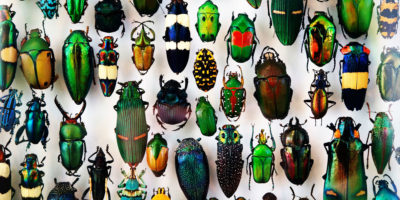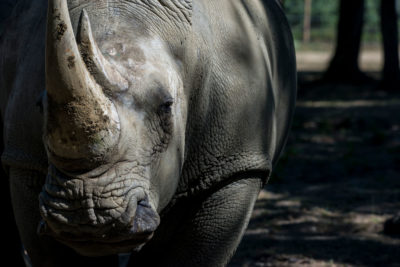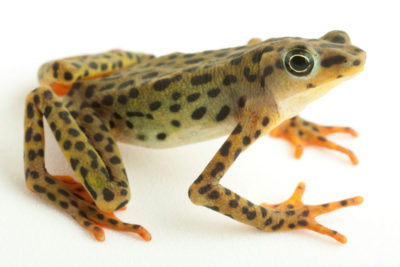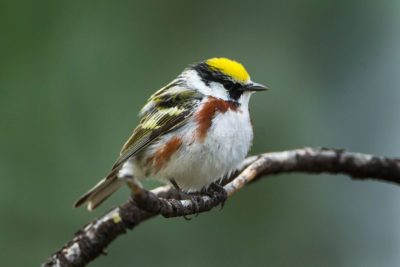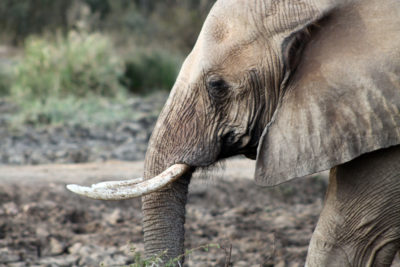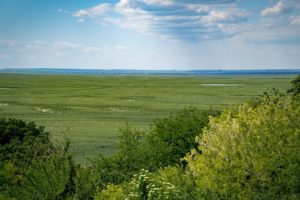A few years ago, I helped lead a ship-based expedition along south Alaska during which several scientists and noted artists documented and made art from the voluminous plastic trash that washes ashore even there. At Katmai National Park, we packed off several tons of trash from as distant as South Asia. But what made Katmai most memorable was: huge brown bears. Mothers and cubs were out on the flats digging clams. Others were snoozing on dunes. Others were patrolling.
During a rest, several of us were sitting on an enormous drift-log, watching one mother who’d been clamming with three cubs. As the tide flooded the flat, we watched in disbelief as she brought her cubs up to where we were sitting — and stepped up on the log we were on. There was no aggression, no tension; she was relaxed. We gave her some room as she paused on the log, and then she took her cubs past us into a sedge meadow. Because she was so calm, I felt no fear. I felt the gift.
In this protected refuge, bears could afford a generous view of humans. Whoever protected this land certainly had my gratitude.
In the early 20th century, a botanist named Robert F. Griggs discovered Katmai’s volcanic “Valley of Ten Thousand Smokes.” In love with the area, he spearheaded efforts to preserve the region’s wonders and wildlife. In 1918, President Woodrow Wilson established Katmai National Monument (now Katmai National Park and Preserve), protecting 1,700 square miles, thus ensuring a home for bear cubs born a century later, and making possible my indelible experience that day. As a legacy for Griggs’ proclivity to share his love of living things, George Washington University later established the Robert F. Griggs Chair in Biology.
That chair is now occupied by a young professor whose recent writing probably has Griggs spinning in his grave. He is R. Alexander Pyron. A few months ago, The Washington Post published a “Perspective” piece by Pyron that is an extreme example of a growing minority opinion in the conservation community, one that might be summarized as, “Humans are profoundly altering the planet, so let’s just make peace with the degradation of the natural world.”
No biologist is entitled to butcher the scientific fundamentals on which they hang their opinions.
Pyron’s essay – with lines such as, “The only reason we should conserve biodiversity is for ourselves, to create a stable future for human beings” and “[T]he impulse to conserve for conservation’s sake has taken on an unthinking, unsupported, unnecessary urgency” – left the impression that it was written in a conservative think tank, perhaps by one of the anti-regulatory zealots now filling posts throughout the Trump administration. Pyron’s sentiments weren’t merely oddly out of keeping with the legacy of the man whose name graces his job title. Much of what Pyron wrote is scientifically inaccurate. And where he stepped out of his field into ethics, what he wrote was conceptually confused.
Pyron has since posted, on his website and Facebook page, 1,100 words of frantic backpedaling that land somewhere between apology and retraction, including mea culpas that he “sensationalized” parts of his own argument and “cavalierly glossed over several complex issues.” But Pyron’s original essay and his muddled apology do not change the fact that the beliefs he expressed reflect a disturbing trend that has taken hold among segments of the conservation community. And his article comes at a time when conservation is being assailed from other quarters, with a half-century of federal protections of land being rolled back, the Endangered Species Act now more endangered than ever, and the relationship between extinction and evolution being subjected to confused, book-length mistreatment.
Pyron’s original opinion piece, so clear and unequivocal in its assertions, is a good place to unpack and disentangle accelerating misconceptions about the “desirability” of extinction that are starting to pop up like hallucinogenic mushrooms.
In recent years, some biologists and writers have been distancing themselves from conservation’s bedrock idea that in an increasingly human-dominated world we must find ways to protect and perpetuate natural beauty, wild places, and the living endowment of the planet. In their stead, we are offered visions of human-dominated landscapes in which the stresses of destruction and fragmentation spur evolution.
White rhinoceros (Ceratotherium simum). Source: Herman Pijpers/Flickr
Conservation International ditched its exuberant tropical forest graphic for a new corporate logo whose circle and line were designed to suggest a human head and outstretched arms. A few years ago, Peter Kareiva, then chief scientist for The Nature Conservancy, said, “conservationists will have to jettison their idealized notions of nature, parks, and wilderness,” for “a more optimistic, human-friendly vision.” Human annihilation of the passenger pigeon, he wrote, caused “no catastrophic or even measurable effects,” characterizing the total extinction of the hemisphere’s most abundant bird — whose population went from billions to zero inside a century (certainly a “measurable effect” in itself) — as an example of nature’s “resilience.”
British ecologist Chris Thomas’s recent book, Inheritors of the Earth: How Nature is Thriving in an Age of Extinction, argues that the destruction of nature creates opportunities for evolution of new lifeforms that counterbalance any losses we create, an idea that is certainly optimistic considering the burgeoning lists of endangered species. Are we really ready to consider that disappearing rhinos are somehow counterbalanced by a new subspecies of daisy in a railroad track? Maybe it would be simpler if Thomas and his comrades just said, “We don’t care about nature.’’
Enter Pyron, who — at least in his initial essay — basically said he doesn’t. He’s entitled to his apathy, but no biologist is entitled to butcher the scientific fundamentals on which they hang their opinions.
Pyron began with a resonant story about his nocturnal rediscovery of a South American frog that had been thought recently extinct. He and colleagues collected several that, he reassured us, “are now breeding safely in captivity.” As we breathed a sigh of relief, Pyron added, “But they will go extinct one day, and the world will be none the poorer for it.”
The conviction that today’s slides toward mass extinction are not inevitable spurred the founding of the conservation movement.
I happen to be writing this in the Peruvian Amazon, having just returned from a night walk to a light-trap where I helped a biologist collect moths. No one yet knows how many species live here. Moths are important pollinators. Knowing them helps detangle a little bit of how this rainforest works. So it’s a good night to mention that the number of species in an area carries the technical term “species richness.” More is richer, and fewer is, indeed, poorer. Pyron’s view lies outside scientific consensus and societal values.
Pyron wasn’t concerned about his frogs going extinct, because, “Eventually, they will be replaced by a dozen or a hundred new species that evolve later.” But the timescale would be millennia at best — meaningless in human terms — and perhaps never; hundreds of amphibians worldwide are suffering declines and extinctions, raising the possibility that major lineages and whole groups of species will vanish. Pyron seemed to have no concerns about that possibility, writing, “Mass extinctions periodically wipe out up to 95 percent of all species in one fell swoop; these come every 50 million to 100 million years.”
But that’s misleading. “Periodically” implies regularity. There’s no regularity to mass extinctions. Not in their timing, nor in their causes. The mass extinctions are not related. Three causes of mass extinctions — prolonged worldwide atmosphere-altering volcanic eruptions; a dinosaur-snuffing asteroid hit; and the spreading agriculture, settlement, and sheer human appetite driving extinctions today — are unrelated.
Rio Pescado stubfoot toad (Atelopus balios). Source: De Investigación y Conservación de Anfibios/Flickr
The conviction that today’s slides toward mass extinction are not inevitable, and could be lessened or avoided, spurred the founding of the conservation movement and created the discipline of conservation biology.
But Pyron seems unmoved. “Extinction is the engine of evolution, the mechanism by which natural selection prunes the poorly adapted and allows the hardiest to flourish,” he declared. “Species constantly go extinct, and every species that is alive today will one day follow suit. There is no such thing as an ‘endangered species,’ except for all species.”
Let us unpack. Extinction is not evolution’s driver; survival is. The engine of evolution is survival amidst competition. It’s a little like what drives innovation in business. To see this, let’s simply compare the species diversity of the Northern Hemisphere, where periodic ice sheets largely wiped the slate clean, with those of the tropics, where the evolutionary time clock continued running throughout. A couple of acres in eastern temperate North America might have a dozen tree species or fewer. In the Amazon a similar area can have 300 tree species. All of North American has 1,400 species of trees; Brazil has 8,800. All of North America has just over 900 birds; Colombia has 1,900 species. All of North America has 722 butterfly species. Where I am right now, along the Tambopata River in Peru, biologists have tallied around 1,200 butterfly species.
Competition among living species drives proliferation into diversified specialties. Specialists increasingly exploit narrowing niches. We can think of this as a marketplace of life, where little competition necessitates little specialization, thus little proliferation. An area with many types of trees, for instance, directly causes the evolution of many types of highly specialized pollinating insects, hummingbirds, and pollinating bats, who visit only the “right” trees. Many flowering plants are pollinated by just one specialized species.
Pyron muddles several kinds of extinctions, then serves up further misunderstanding of how evolution works. So let’s clarify. Mass extinctions are global; they involve the whole planet. There have been five mass extinctions and we’ve created a sixth. Past mass extinctions happened when the entire planet became more hostile. Regional wipeouts, as occurred during the ice ages, are not considered mass extinctions, even though many species can go extinct. Even without these major upheavals there are always a few species blinking out due to environmental changes or new competitors. And there are pseudo-extinctions where old forms no longer exist, but only because their descendants have changed through time.
New species do not suddenly “arise,” nor are they really new. They evolve from existing species, as population gene pools change.
Crucially for understanding the relationship between extinction and evolution is this: New species do not suddenly “arise,” nor are they really new. New species evolve from existing species, as population gene pools change. Many “extinct” species never really died out; they just changed into what lives now. Not all the dinosaurs went extinct; theropod dinosaurs survived. They no longer exist because they evolved into what we call birds. Australopithecines no longer exist, but they did not all go extinct. Their children morphed into the genus Homo, and the tool- and fire-making Homo erectus may well have survived to become us. If they indeed are our direct ancestor — as some species was — they are gone now, but no more “extinct” than our own childhood. All species come from ancestors, in lineages that have survived.
Pyron’s contention that the “hardiest” flourish is a common misconception. A sloth needs to be slow; a faster sloth is going to wind up as dinner in a harpy eagle nest. A white bear is not “hardier” than a brown one; the same white fur that provides camouflage in a snowy place will scare away prey in green meadow. Bears with genes for white fur flourished in the Arctic, while brown bears did well amidst tundra and forests. Polar bears evolved from brown bears of the tundra; they got so specialized that they separated, then specialized further. Becoming a species is a process, not an event. “New” species are simply specialized descendants of old species.
True extinctions beget nothing. Humans have recently sped the extinction rate by about a thousand times compared to the fossil record. The fact that the extinction of dinosaurs was followed, over tens of millions of years, by a proliferation of mammals, is irrelevant to present-day decisions about rhinos, elephant populations, or monarch butterflies. Pyron’s statement, “There is no such thing as an ‘endangered species,’ except for all species,” is like saying there are no endangered children except for all children. It’s like answering “Black lives matter” with “All lives matter.” It’s a way of intentionally missing the point.
Chestnut-sided warbler (Setophaga pensylvanica). Source: Francesco Veronesi/Wikimedia
Here’s the point: All life today represents non-extinctions; each species, every living individual, is part of a lineage that has not gone extinct in a billion years.
Pyron also expressed the opinion that “the only reason we should conserve biodiversity is for ourselves …” I don’t know of another biologist who shares this opinion. Pyron’s statement makes little practical sense, because reducing the diversity and abundance of the living world will rob human generations of choices, as values change. Save the passenger pigeon? Too late for that. Whales? A few people acted in time to keep most of them. Elephants? Our descendants will either revile or revere us for what we do while we have the planet’s reins in our hands for a few minutes. We are each newly arrived and temporary tourists on this planet, yet we find ourselves custodians of the world for all people yet unborn. A little humility, and forbearance, might comport.
Thus Pyron’s most jarring assertion: “Extinction does not carry moral significance, even when we have caused it.” That statement is a stranger to thousands of years of philosophy on moral agency and reveals an ignorance of human moral thinking. Moral agency issues from an ability to consider consequences. Humans are the species most capable of such consideration. Thus many philosophers consider humans the only creatures capable of acting as moral agents. An asteroid strike, despite its consequences, has no moral significance. Protecting bears by declaring Katmai National Monument, or un-protecting Bears Ears National Monument, are acts of moral agency. Ending genetic lineages millions of years old, either actively or by the willful neglect that Pyron advocates, certainly qualifies as morally significant.
Do we really wish a world with only what we “rely on for food and shelter?” Do animals have no value if we don’t eat them?
How can we even decide which species we “directly depend’’ upon? We don’t directly depend on peacocks or housecats, leopards or leopard frogs, humpback whales or hummingbirds or chestnut-sided warblers or millions of others. Do we really wish a world with only what we “rely on for food and shelter,” as Pyron seemed to advocate? Do animals have no value if we don’t eat them? I happen not to view my dogs as food, for instance. Things we “rely on” make life possible, sure, but the things we don’t need make life worthwhile.
When Pyron wrote, “Conservation is needed for ourselves and only ourselves… If this means fewer dazzling species, fewer unspoiled forests, less untamed wilderness, so be it,” he expressed a dereliction of the love, fascination, and perspective that motivates the practice of biology.
Here is a real biologist, Alfred Russell Wallace, co-discoverer of evolution by natural selection:
I thought of the long ages of the past during which the successive generations of these things of beauty had run their course … with no intelligent eye to gaze upon their loveliness, to all appearances such a wanton waste of beauty… . This consideration must surely tell us that all living things were not made for man… . Their happiness and enjoyments, their loves and hates, their struggles for existence, their vigorous life and early death, would seem to be immediately related to their own well-being and perpetuation alone. —The Malay Archipelago, 1869
At the opposite pole of Wallace’s human insight and wonder, Pyron asked us to become complicit in extinction. “The goals of species conservation have to be aligned with the acceptance that large numbers of animals will go extinct,” he asserted. “Thirty to 40 percent of species may be threatened with extinction in the near future, and their loss may be inevitable. But both the planet and humanity can probably survive or even thrive in a world with fewer species … The species that we rely on for food and shelter are a tiny proportion of total biodiversity, and most humans live in — and rely on — areas of only moderate biodiversity, not the Amazon or the Congo Basin.”
African elephant (Loxodonta africana). Source: Flowcomm/Flickr
Right now, in the Amazon as I type, listening to nocturnal birds and bugs and frogs in this towering emerald cathedral of life, thinking such as Pyron’s strikes me as failing to grasp both the living world and the human spirit.
The massive destruction that Pyron seems to so cavalierly accept isn’t necessary. When I was a kid, there were no ospreys, no bald eagles, no peregrine falcons left around New York City and Long Island where I lived. DDT and other hard pesticides were erasing them from the world. A small handful of passionate people sued to get those pesticides banned, others began breeding captive falcons for later release, and one biologist brought osprey eggs to nests of toxically infertile parents to keep faltering populations on life support. These projects succeeded. All three of these species have recovered spectacularly and now again nest near my Long Island home. Extinction wasn’t a cost of progress; it was an unnecessary cost of carelessness. Humans could work around the needs of these birds, and these creatures could exist around development. But it took some thinking, some hard work, and some tinkering.
It’s not that anyone thinks humans have not greatly changed the world, or will stop changing it. Rather, as the great wildlife ecologist Aldo Leopold wrote in his 1949 classic A Sand County Almanac, “To keep every cog and wheel is the first precaution of intelligent tinkering.”
